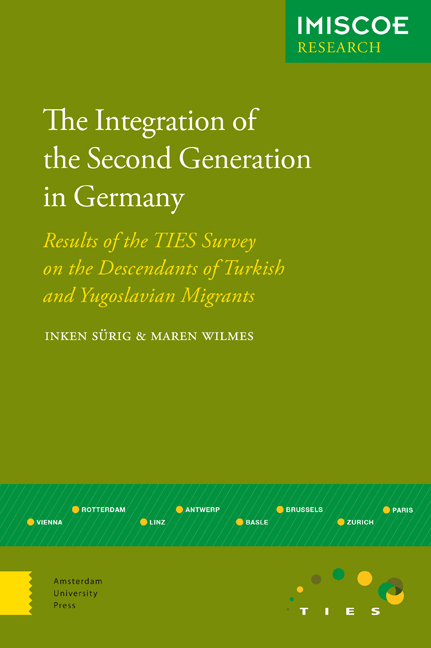 The Integration of the Second Generation in Germany
The Integration of the Second Generation in Germany Book contents
- Frontmatter
- Contents
- Preface: The International Research Project TIES
- 1 Introduction
- 2 Migration History and Basic Demographic Characteristics of the First Generation
- 3 Educational Careers and Educational Outcomes
- 4 Labour Market Positions
- 5 Segregation and Housing
- 6 Ethnic and Cultural Orientations
- 7 Social Relations
- 8 Family Formation and Partner Relationships
- 9 Conclusions and International Comparisons
- References
- Other IMISCOE Research Titles
7 - Social Relations
Published online by Cambridge University Press: 11 December 2020
- Frontmatter
- Contents
- Preface: The International Research Project TIES
- 1 Introduction
- 2 Migration History and Basic Demographic Characteristics of the First Generation
- 3 Educational Careers and Educational Outcomes
- 4 Labour Market Positions
- 5 Segregation and Housing
- 6 Ethnic and Cultural Orientations
- 7 Social Relations
- 8 Family Formation and Partner Relationships
- 9 Conclusions and International Comparisons
- References
- Other IMISCOE Research Titles
Summary
Introduction
In the preceding chapter on ethnic and cultural orientations, it was pointed out that self-descriptions in terms of ethnic and cultural affiliations are not necessarily connected with actual social practices. Social relations have to be negotiated on the basis of similarities as well as discrepancies, and the very nature of multicultural society dictates that minority groups in particular are unlikely to be completely limited to their own group. This section investigates social integration in terms of social relations such as friendships, social practices such as public participation, and the perception of a general social climate in terms of discriminatory tendencies. When it comes to immigrants, social integration is often associated with notions of assimilation. The assumption here is that the degree of social interaction with the majority population (interethnic contacts, public participation) is indicative of the degree of social integration. It is assumed that the stronger the social orientation of migrants towards their own group, the stronger the degree of ‘ethnic’ segmentation (see Esser 2001). At the same time, an understanding of ‘assimilation’ as the individual and collective orientation towards institutionalised social expectations risks overemphasising immigrants’ obligations towards majority society. This then tends to lead to an underestimation of the importance of actual access to relevant social domains (see Bommes 2004b; Sauer, Halm & Stiftung Zentrum fur Turkeistudien 2009). Opportunities for public participation and forming social relations thus depend not only on the individual abilities and attitudes of both the majorities and the minorities, but also on the inherent uncertainties of complex social systems.
In this context, it is important to bear in mind that the TIES second generation in Germany was born and socialised in this country, and that most of them are German citizens. The mechanisms and dynamics of their inclusion can therefore be expected to differ substantially from those relevant for the parental generation. On the one hand, the second generation can make use of pre-established origin-related and cultural networks, including solidarity and support structures that were largely unavailable to their parents. On the other hand, growing up in Germany means an initial cultural assimilation, in terms of familiarity with the values and standards of the German democratic welfare state.
- Type
- Chapter
- Information
- The Integration of the Second Generation in GermanyResults of the TIES Survey on the Descendants of Turkish and Yugoslavian Migrants, pp. 151 - 168Publisher: Amsterdam University PressPrint publication year: 2015


